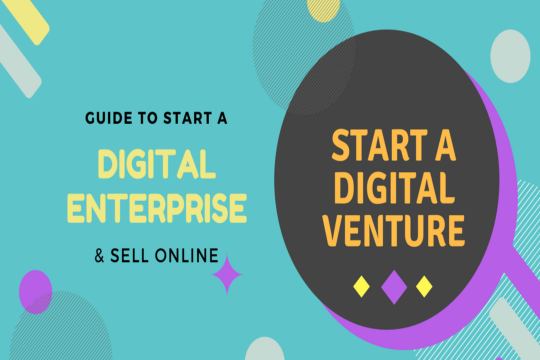Let’s say that you have an offline store and is planning to venture into the digital world. It’s great that you noticed the momentum.
A study conducted by Hootsuite and We are Social found that there are more than 4 billion internet users. Thinking why to start with statistics, they are just to boost your confidence. You are on the right track. You made the right decision to position your business among the online dwellers.
Still, if you don’t have an online store then don’t wait, Create An eCommerce Store and Sell Online! If you have an online presence and is looking for hacks to boost your online sales then let me help you with that.
7 Steps to Start a Digital Enterprise and Sell Online

1. Understand the Industry
Regardless of what kind of business you are into it is important that you have done a thorough research on how the industry operates. That’s one good reason why most entrepreneurs give importance to resources that comes with some industry relevance. The work gets easier when an entrepreneur has an overview of what is happening in the industry, what are the best practices, and how the new market changes will impact the business.
If you are a newbie and is planning to start a journey into a not so familiar niche, then I strongly recommend you to buckle up. It is going to be a bumpy ride.Second thoughts, Rather, isn’t it wise to take your time to learn how the market/ industry operates, and then invest in areas that you feel confident.
Example:
Consider this example, you are planning to start a home-based business and sell apparels online. To sell apparels online you need to understand the fashion and apparel industry. Unless and until you are sure about what the market demand is, it gets tougher for you to source the relevant inventory, or to position your products. Hoarding high volume of luxury apparels may not be the right choice.
If you don’t know which products have a better commercial value when compared to other products you most likely end-up hoarding the wrong choices. Products that don’t perform well in terms of sales is a liability.The fashion industry is a highly volatile market. How people perceive a brand or a signature outfit can change radically. If you are not keeping yourself up to date with the latest industry/ market trends then you will be left behind offering the same old products.
Visit a textile manufacturer. Enquire the different manufacturing processes. Find whether any of the manufacturers have an eco-friendly/ sustainable fabric manufacturing process in motion. If yes, ask them why an eco-friendly process and what’s the demand for sustainable outfits. You may be able to find a niche segment which is yet to be explored/ exploited.Go for a stroll, visit few apparels stores nearby. Spend some time in individual stores, monitor how the day to day operations are handled.
If the offline store has an online presence don’t forget to go through it. Give attention to detail. When you repeat the process for multiple apparel firms then you will be able to plot a pattern that will help you understand what are the best practices and how to inculcate those practice in your online venture. Better learn from the existing market than to perish.
2. Customer Centric Strategy for the Right Audience
Almost all companies are result oriented or customer focused. It is great, but it’s better if you have a customer-centric strategy. Customer-centric means, pioneering in a culture that reflects an exciting experience to the customer which is not limited as a short-term strategy rather an idea that tends to add value to the customer’s day to day life.Brands need to rely on insights driven strategies to provide a personalised experience to the customers.
A customer-centric (customer first) approach will help an organisation to provide an exceptional experience to the customer and keep the customer engaged for a long time. The longer the customer feels cared, higher the chance for the entity to remain competitive in the market.
In a digital world dominated by discounts and offers its important for a business to foster a long-lasting relationship with the customers. The lifetime value of a customer needs to be given due consideration. A customer-centric strategy help bring repeated sales.
3. Audience Persona to Target the Right Customer
An audience persona is an architectural representation of your ideal customer. To draft an effective customer-centric strategy you need to understand who to target.
A well-designed audience personal will help understand the needs, wants, and aspirations of your customers. By creating a buyer’s persona a digital marketer will get deep insights into, what market to target, what motivates the customer to engage with a business, what solution are they looking for, why and how they buy the product, etc. Right from the inception stage, a business needs to consider the importance of making use of buyer’s persona.
The practice of iterating your product design base on the requirement of customers will help develop great products that are meant to meet the demands of a specific niche segment. Ever heard of the term MVP “Minimum Viable product”, the lean strategy will help you design a winning strategy.
With MVP the product itself is designed with a customer first concept. The entity forces itself to test the product to understand the demand for a specific feature, or to identify to what extent the market demands can be solved with the product.
4. The Good Old Day of Mediocre is Over
To compete with the best, you need to be the best. Best in using creativity and innovating your business model in a way to grab the visitors attention. At times we forget the fact that there is a person at the end of every communication channel, and the creative/ message should inspire him/ her to interact and engage with the platform.
Mediocre messages are not enough. With nearly a huge amount of textual chunks getting added to the digital networks, it’s important that a pinch of creativity is blended all along the buyer’s journey.
On an average how many emails hit your inbox on a daily basis. Why you decided to skip the first five and opened the sixth email. What was special with the email. YES, the message was creative enough that you want to know what value does the email carries. Simple as that. A small customised message was able to increase the Click Through Rate. There are minuscule factors similar to it, where you need to be creative in delivering the message.
Differentiate your business such that every action they take will help find value.
5. Content Creation and Content Marketing
- Content Creation along the Buyer’s Journey
- Every content you create needs to be mapped with an ideal customer.
- Puzzled how to create a content plan that helps you carry out the process. Let me help you.
First, dig through your buyer’s persona, and identify where to place the customer on the buyer’s journey. Ask the question, whether the customer falls in the awareness stage, consideration stage, or the decision stage. Based on the position of the customer you need to decide what kind of content should be created.
In the awareness stage, you need to educate the customer, whereas at the decision stage you need to make sure that the customer will find it beneficial to avail/ onboard your services. Use user-generated content, testimonials, comparisons, etc to highlight the significance of owning the product. User-generated content and video testimonials help kindle a sense of trust and confidence among customers.
6. Content Marketing to Spread the Word
You may have the best content with you, but if you don’t market it then it will be extremely hard for people to derive benefit out of it.
Having a clearly defined content creation and content marketing strategy will not only help you plan your business operations rather it will help you set milestones and evaluate your ROI. Stats published on SmartInsights.com clearly states that 78% of the respondents said that their organization have a content marketing strategy set aside.
7. Brand Advocates
Business needs to enrich their customers with personalised messages. Every business needs a loyal customer base to succeed. Rewards and loyalty programs are one great strategy used by businesses to bring customers back to their shop and maintain a healthy relationship.
People feel cared about your business for a specific reason, you need to find those drivers and amplify them. A study conducted by Deloitte found that a high retention rate of 37% is found among customers that are referred by other customers. Now, you see the power of brand advocates.
About Author
I am Vickky Nix, a fun loving guy, and a digital aficionado. Being active in the digital world, I picked up one or two important points, First – I am waging a war on mediocrity in content creation/ marketing. Second – Are you planning to go on a digital expedition? Start Now! Shopnix is a best starting point. Connect With Me:- LinkedIn.
















